A line laser detection screen design and projectile echo power calculation in detection screen area
2022-08-30HanshanLiXiaoqianZhangXueweiZhangQuanminGuo
Han-shan Li,Xiao-qian Zhang,Xue-wei Zhang,Quan-min Guo
School of Electronic and Information Engineering,Xi'an Technological University,Xi'an,710021,China
Keywords:Line laser detection screen Photoelectric detection target Photoelectric detection receiver Echo power Projectile
ABSTRACT A line laser with high power as the background light source for the design of a new photoelectric detection target is proposed in this paper,aiming to improve the detection ability of the traditional photoelectric detection target under low background illumination.The laser emitted pulse waveform function and the laser echo pulse response function were used to establish the mathematical model of the reflected echo power of projectile in the detection area and derive the calculation function of minimum detectable echo power in the line laser detection screen,according to information of the line laser emitted power,incident angle of projectile,duration time and detection distance of projectile passing through the line laser detection screen.Calculations and experimental results showed that the design method of line laser detection screen and calculation model of laser echo power are reasonable,and the detection ability of line laser detection screen is obviously higher than that of traditional photoelectric detection screen,especially in low background illumination;at the same time,the designed line laser detection screen was used to combine a six line laser detection screen intersection test system,based on live ammunition for shooting.The test system is stable and able to obtain the dynamic parameters of the flying projectile,verifying that the design of the line laser detection screen in new photoelectric detection target can be suitable for shooting range test applications.
1.Introduction
The photoelectric detection target is a sensor used to determine the information of flying projectiles in a weapon test range and it is composed of the lens,the slit diaphragm,the photoelectric detection receiver and the signal processing amplifier circuit.The slit diaphragm through the lens forms the detection screen,as shown in Fig.1.The alternating projectile imaging information is formed in the detection screen area,when the projectile passes through the detection screen.The alternating signal is obtained at the photoelectric detection target terminal,through the photoelectric detection receiver and signal processing amplifying circuit.If combined with the comparison circuit,the instantaneous second impulse signal can be obtained[1].Multiple photoelectric detection targets can be combined with different spatial relation detection screens,and parameters such as the flight projectile velocity,the coordinates of the projectile passing through the detection screen and the density can be tested based on the working principle of the photoelectric detection target [2,3].Gao et al.introduced the four detection screen intersection test method and established the projectile coordinate calculation function [4].Tian et al.described and analyzed a six detection screen intersection test system based on photoelectric detection target and calculated the error produced by engineering uncertainty [5].Ni et al.set up a seven detection screen intersection system based on photoelectric detection target and given the calculation model of projectile flight parameters[6].The previous work have studied different spatial structure detection screens by using multiple photoelectric detection targets and realized the test function of projectile dynamic parameters under different test conditions.These test systems provide new insights into the development of the weapon test range.From the perspective of the test mechanism of multiple photoelectric detection targets,the detection performance of photoelectric detection targets that make up the test system determines the reliability of the test system.Therefore,stable detection performance of the photoelectric detection target restricts the development of multiple detection screen intersection test technology.
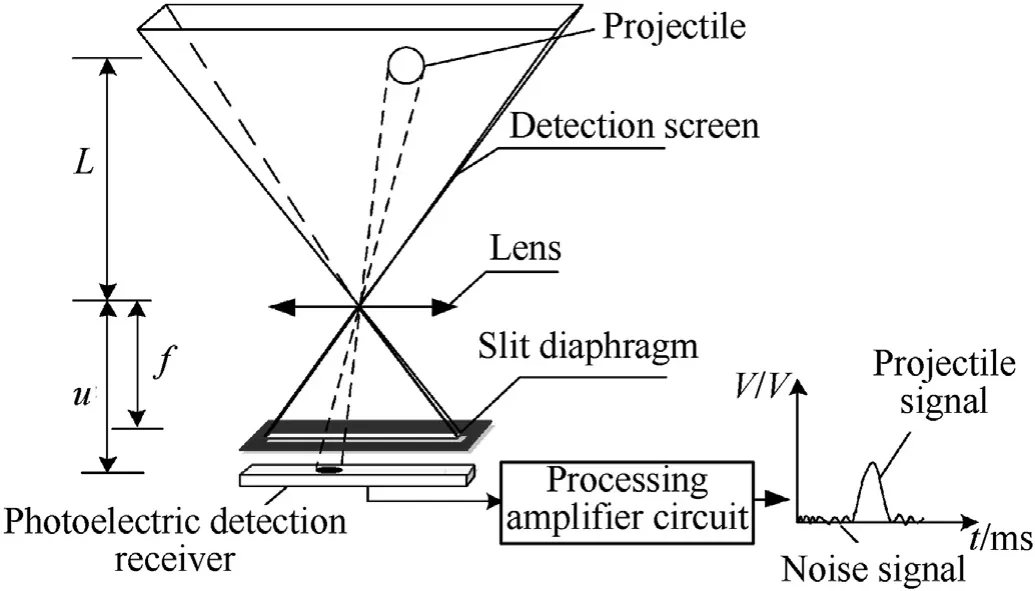
Fig.1.Schematic diagram of the traditional photoelectric detection target for projectile detection.
As the photoelectric detection target uses natural light as the background light source,in addition to the hardware elements of the detection system,environmental factors determine the detection ability of the photoelectric detection target.The detection ability index of the photoelectric detection target is determined by the diameter of the detected projectile,for example,if the diameter of the projectile is 7.62 mm,and the limiting detection distance of the photoelectric detection target is 7.62 m,then,the detection ability index of the current photoelectric detection target is 1000 times the diameter of the projectile and this detection distance index is related to the selected optical system.Certain test conditions need to be met to achieve this index,that is,a certain illumination background is required.A background illumination that is too high or too low is not conducive to achieve this index.Specifically,in the condition of low illumination(i.e.,less than 1000 lx)or blue sky background,due to the environment factors of the current photoelectric detection receiver,the detection ability of the photoelectric detection target cannot reach 300 times the diameter of projectile,which is far less than the detection index of weapon test system.Therefore the application range of traditional photoelectric detection target in all-weather conditions is greatly limited.
A considerable amount of research worker have focused on improving the detection ability of the traditional photoelectric detection target.Gao et al.investigated a new photoelectric detection target by using high-sensitivity array photoelectric detectors [7].Lou et al.proposed a Hopfield auto-associative neural network signal recognition method to improve the recognition ability of the photoelectric detection target [8].El_Tokhy et al.established the detection sensitivity calculation model of the photoelectric detection target[9],and Zhang et al.analyzed a highsensitivity adaptive gain processing circuit from the perspective of the detection circuit [10].These improvement measures have effectively improved the detection ability of the traditional photoelectric detection target.However,under low illumination conditions and dark blue sky background conditions,the detection ability of the traditional photoelectric detection target cannot be effectively improved,regardless of the photoelectric detection receiver used.The improved detection ability under such conditions does not exceed 400 times the diameter of the projectile,however,in the actual weapon shooting range test,the required detection ability index of the photoelectric detection target generally exceeds 700 times the diameter of the projectile.Furthermore,the existing design methods of the traditional photoelectric detection target have limitations.In order to improve the detection ability of the photoelectric detection target considerably,without changing the detection mode of the traditional photoelectric detection target,a new photoelectric detection target with line laser detection screen was designed in this study.The proposed target uses high-power line laser as an auxiliary light source,combines the line laser with the optical system of traditional photoelectric detection target and the line laser plane coincides with the detection screen plane of the traditional photoelectric detection target;in order to study the detection ability of line laser detection screen,we need to establish the calculation model of laser echo power in the line laser detection screen.
2.Design method of line laser detection screen of new photoelectric detection target
In order address the issue of insufficient detection ability of traditional photoelectric detection targets in low illumination and blue sky background,the line laser was used as the background light source,according to the reflected energy of the projectile irradiated by the line laser.The detection method was used as the sensing information source of the photoelectric detection receiver and the design principle of line laser photoelectric sensor is shown in Fig.2.Line laser photoelectric sensor is different from traditional photoelectric detection target,its detection mechanism is that when the projectile passes through the line laser emission plane,the line laser illuminate the projectile's surface and the reflected laser energy of the projectile enters the photoelectric detection receiver through the lens and the slit aperture,and the reflected laser echo energy of the projectile is received by the photoelectric detection receiver.
In Fig.2,the distance between the line laser and the lens of traditional photoelectric detection target is d,and the detection plane І is the detection area of traditional photoelectric detection target sensor,which is composed of an lens,a slit diaphragm,a photoelectric detection receiver and a detection signal amplifier processing circuit.The slit diaphragm forms a fan-shaped detection plane with a certain thickness through the lens,called the detection screen [11-13].The detection plane ІІ is the emitted area of line laser,which is expanded by the high-power emitted line laser through the turning optical prism assembly into a fan-shaped line laser plane with a certain thickness.This detection plane coincides with the detection plane І and the detection area ІІІ is the overlapping detection area,called the line laser detection screen.The combination of line laser and traditional photoelectric detection target is designed as the photoelectric sensor with line laser detection screen,which is called new photoelectric detection target in this paper.When the projectile passes through the overlapping detection areaІІІ,the laser irradiates the surface of the projectile,forming diffuse reflection,and the reflected light enters the photoelectric detection receiver.The sensitive surface of the photoelectric detection receiver senses the reflected light energy of the projectile and outputs the instantaneous change signal of terminal detection output circuit of the new photoelectric detection target through the amplifying and processing circuit.If the peak of the projectile signal meets the minimum detection signal-to-noise ratio,the test system can capture the information of the projectile.
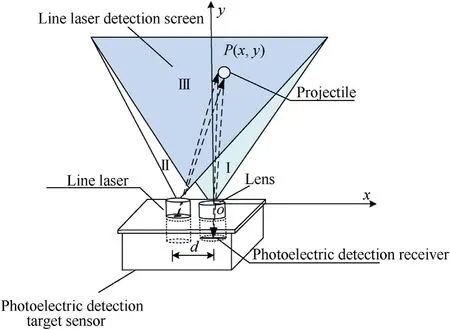
Fig.2.The design schematic diagram of line laser detection screen of new photoelectric detection target.
From the perspective of optical principles,for the detection areaIII,the distance between the projectile and the lens is different,and the thickness of detection screen at this position is also different,makes the ratio of the cross-sectional area of the projectile to the cross-sectional area of the detection screen at the certain height different,and the energy reflected to the photoelectric detection receiving surface is also different.In order to objectively analyze the detection ability of new photoelectric detection target,it is necessary to establish a correlation function of the detection system output and the reflected echo power of projectile,and the calculation model of minimum detectable echo power.
3.Projectile echo power calculation method of line laser detection screen
The lens of new photoelectric detection target is considered as the center coordinate origin,ois the origin of coordinate system,d is the distance between the line laser and the lens,because d is relatively short,the influence of this distance can be ignored(Fig.2).Assuming that the emitted power of the line laser is p,P(x,y)is the position of the projectile passing through the line laser detection screen,the reflected echo power ideally received by the photoelectric detection receiver is Pand can be expressed by formula (1).

where Sis the cross-sectional area of the projectile irradiated by the line laser when the projectile passing through the line laser detection screen,Sis the scattering cross-section of the projectile's surface,Dis the receiving aperture area of the optical system,εis the system transmission efficiency andα is the atmospheric attenuation coefficient [14].
Assuming that the incident angle of the projectile passing through the line laser detection screen isβ,as shown in Fig.3,the reflected echo power ideally received by the photoelectric detection receiver can be calculated by formula (2).

where μis the reflection coefficient of the line laser illuminated on the surface of the projectile.
For the line laser detection screen,the reflected laser energy of the projectile is obtained by the photoelectric detection receiver,which is related to the emitted time pulse of the line laser,projectile reflection coefficient,detection distance,flying angle and velocity of the projectile.In order to provide a scientifically rigorous formulation of the reflected laser echo power function of projectile,it is necessary to comprehensively consider the influence of multiple factors in the line laser photoelectric sensor.
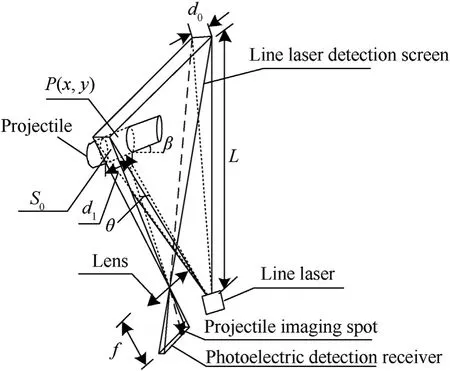
Fig.3.Schematic diagram of the detection echo signal when a projectile passes through the line laser detection screen.
According to the principle of Figs.2 and 3,let the output pulse of the emitted line laser be a Gaussian pulse and formula (3) be the emitted line laser pulse signal distributed in time and space[15,16].

whereΔtis the duration time that the projectile passes through the line laser detection screen.
In Fig.3,lis the length of the projectile,dis the thickness of the detection screen corresponding to the detection distance of L and dis the thickness that the projectile actually intersects with the line laser detection screen at position P(x,y).If the position of the projectile passing through the line laser detection screen is different,and the thickness of the cross-section of the projectile intersecting the line laser detection screen is also different,then,the duration time of the projectile passing through the detection screen is a random variable,expressed by formula (4).

According to Fig.3 and the design principle of line laser detection screen of photoelectric detection target,the line laser detection screen has a certain thickness,which is composed of a fan-shaped laser light source area with a certain thickness(detection plane ІІ)and a detection screen area for receiving the reflected echo of the projectile (detection plane I),among,the detection plane ІІ is formed by the emitted line laser sensor;we can find that when the position of the projectile passing through the line laser detection screen is different,the cross-sectional area of the reflection laser projectile is also different,which is mainly determined by the parameters of the diameter and surface area of the projectile,as well as the thickness parameters of the line laser detection screen at the current position.It can be seen from formula(2)that the line laser energy decreases with the increase of the detection distance,so that the distance of the projectile passing through the line laser detection screen increases,and the reflected laser energy of projectile also decreases.In order to fully receive the reflected laser energy on the surface of the projectile by the photoelectric detection receiver,considering the principle of detection projectile by new photoelectric detection target and the dynamic parameter mechanism of multiple detection screens array composed of new photoelectric detection target,the relationship between the length of projectile and the thickness of line laser detection screen should be considered for the thickness of line laser detection screen of the designed new photoelectric detection target;Normally,the detection ability of photoelectric detection target is determined by the ratio of the cross-sectional area of the projectile formed in the detection screen to the cross-sectional area of the thickness of detection screen at a certain detection distance.Therefore,in the design of line laser detection screen of new photoelectric detection target,it is necessary to consider that the thickness of the fanshaped area of the emitted line laser light source is consistent with that of the line laser detection screen area for receiving the reflected echo of the projectile,so that when the projectile passes through the line laser detection screen,all the reflected laser energy of the projectile can be received by the photoelectric detection receiver,and the detection sensitivity achieves the best effect.It can be seen from Figs.2 and 3 that the detection ability is determined by the thickness of detection screen of the photoelectric detection optical system for receiving the projectile echo energy,therefore,the thickness of detection screen of new photoelectric detection target is determined by the mechanism of detection screen formed by the slit aperture,photoelectric detection receiver and the lens for receiving the reflected echo energy.
Based on the design of line laser detection screen of new photoelectric detection target,in order to scientifically analyze and calculate the echo energy reflected by the projectile,we introduce the laser emitted pulse waveform function and the laser echo pulse response function,to establish the mathematical model of the echo power of projectile.Assuming that the spatial distribution of the line laser light intensity is a Gaussian distribution[17],formula(5)is its light intensity distribution.


The laser echo response is related to the surface characteristics of the projectile and the pulse response can be expressed by using formula (6).

whereδ(·)is the Dirac function,ρ(β)is the bi-directional reflection distribution coefficient of the unit panel and c is the speed of light[18,19].Substituting formula (6) into formula (5),the pulse response can be expressed by formula (7).



The laser pulse echo waveform is the convolution of the emitted laser pulse waveform and the pulse response[15,16],expressed by formula (9).

Because the line laser detection screen belongs to short-range detection,the effects of speckle and atmospheric turbulence can be ignored and the projectile echo power equation can be expressed by formula (10) in the line laser detection screen.

We calculate the responsivity of the photoelectric detection receiver,the voltage amplification factor in the detection circuit and the pulse echo power of the projectile.According to the projectile echo power equation,the line laser emitted power,the position that the projectile passes through line laser detection screen and the output peak signal of the projectile can be calculated by formula(11) in the detection circuit.

where Ris the responsivity of photoelectric detection receiver(A/W) and Ais the voltage amplification parameters in the detection circuit.
4.Calculation model of the minimum detectable projectile echo power
For the line laser detection screen,it is necessary to recognize whether the output projectile signal is greater than a threshold voltage value,called the detectable minimum information of the projectile,in order to determine whether the output signal contains projectile information.The minimum detectable information of the projectile depends on the minimum detectable echo power.According to formulas (10) and (11),the detection output voltage is related to the projectile echo power.Factors such as laser atmospheric attenuation and atmospheric absorption can be ignored,because the detection distance of the system is short-range detection.The output signal of line laser detection screen is the superposition of the projectile self-reflected echo energy and the background noise of the system.Due to the influence of environmental noise,the detection system is likely to fail.According to the minimum detectable power determined by the detection probability and the false alarm probability,when the peak of the projectile reflected echo signal exceeds the minimum detectable optical power,it is deemed that the line laser detection screen successfully detects the information of the projectile,and can be recognized.
The average current of the line laser detection screen in the detection circuit is Iwhen a projectile is passing through and Iwhen no projectile is passing through,thus:
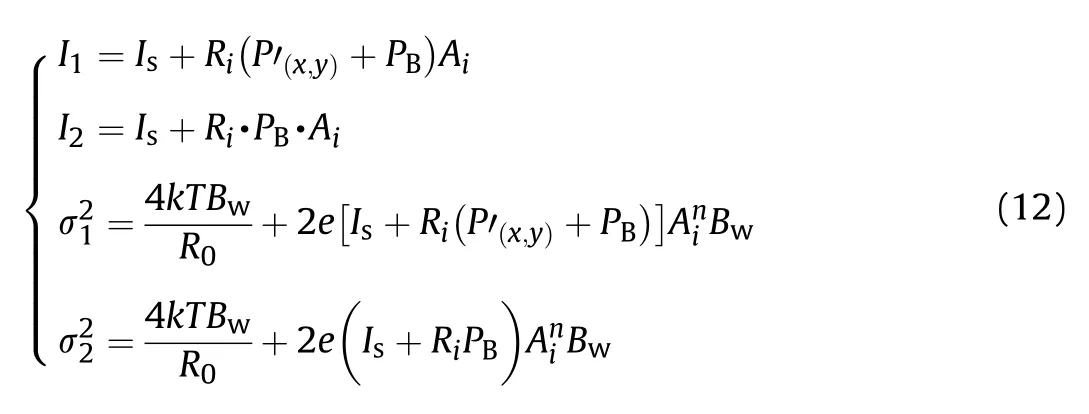
where Pis the background light power detected by the photoelectric detection receiver,Iis the dark current,Bis the noise spectrum bandwidth,eis the unit charge,kis the Boltzmann constant,Ris the load impedance of photoelectric detection receiver,Tis the absolute temperature,nis correlation coefficient of photoelectric detector material (n=2.31) [20],σand σare the respective noise mean square errors,the minimum detectable projectile echo power Pcan be obtained by formula (13) in the line laser detection screen.

The signal-to-noise ratio of the detection system according to minimum detectable projectile echo power can be determined by combining formulas(12)and(13)with the output voltage function of the detection circuit and then diagnose whether the line laser detection screen captures projectile information.
According to the theoretical model of minimum detectable echo power,we can find that minimum detectable echo power is related to the system noise variance,dark current and other parameters.If the hardware parameters of new photoelectric detection target are determined,the intrinsic output noise of the system is only related to the external illumination.However,the emitted line laser of new photoelectric detection target uses a single wavelength pulsed laser,and the emitted laser has the characteristics of fixed wavelength.In the receiving light path of the system,in order to receive the laser echo power without the influence of external illumination,we have added a narrow-band filter in the designed receiving light path module.The selected filter bandwidth is plus or minus 20 nm of the emission laser wavelength,which can effectively reduce the stray light of natural light background.Thus,the maximum detectable echo power of the system can be approximated to be affected only by the emitted laser,and it is related to the laser emitted power,the detection distance and the crosssection area of the projectile's surface reflected laser when the projectile passes through the line laser detection screen.The laser echo power is converted to a voltage signal,whose peak value is greater than the inherent noise of the system,so the projectile information can be thought to be captured.We compare the peak of the projectile signal with the average signal of the inherent noise of the system to determine the minimum detectable echo power.
5.Calculation and experimental analysis
5.1.Calculation analysis
The photoelectric detection target is used in the outer ballistics of the weapon range,its purpose being to check whether the information of the flying projectile can be captured,to address the problem of insufficient environmental illumination or weak detection ability under blue sky background.This paper introduces the line laser as an active light source for the design of the new photoelectric detection target and forming of an active line laser detection screen.In the design of the line laser detection screen,the chosen focal length of the lens was 50 mm,its relative aperture was 1:1.8,the slit diaphragm size was 0.3 mm× 45 mm,the length direction was 45 mm,forming the detection field of view.According to the design parameters,the field of view of the line laser detection screen was 52,the divergent field of view formed by the line laser was 55,the distance between the line laser emitted position and the center of lens was 89 mm,the detection plane of the line laser and the detection screen of the photoelectric detection target completely overlap.The relationship between the projectile echo power and the laser emitted power,detection distance and aperture diaphragm was calculated,based on the design parameters of the line laser detection screen.
The echo energy of the projectile is related to the laser emitted power and the detection distance.When the parameters of the photoelectric detection receiving optical system are known,according to formulas(2),(10)and(11),we calculate the output signal of the photoelectric detection receiver when the laser emitted power changes from 30 W to 60 W,and the detection range of each laser emitted power changes from 3 m to 4.5 m,the relationship between the echo signal of the projectile the and the detection distance is calculated at different laser emitted power settings,as shown in Fig.4.
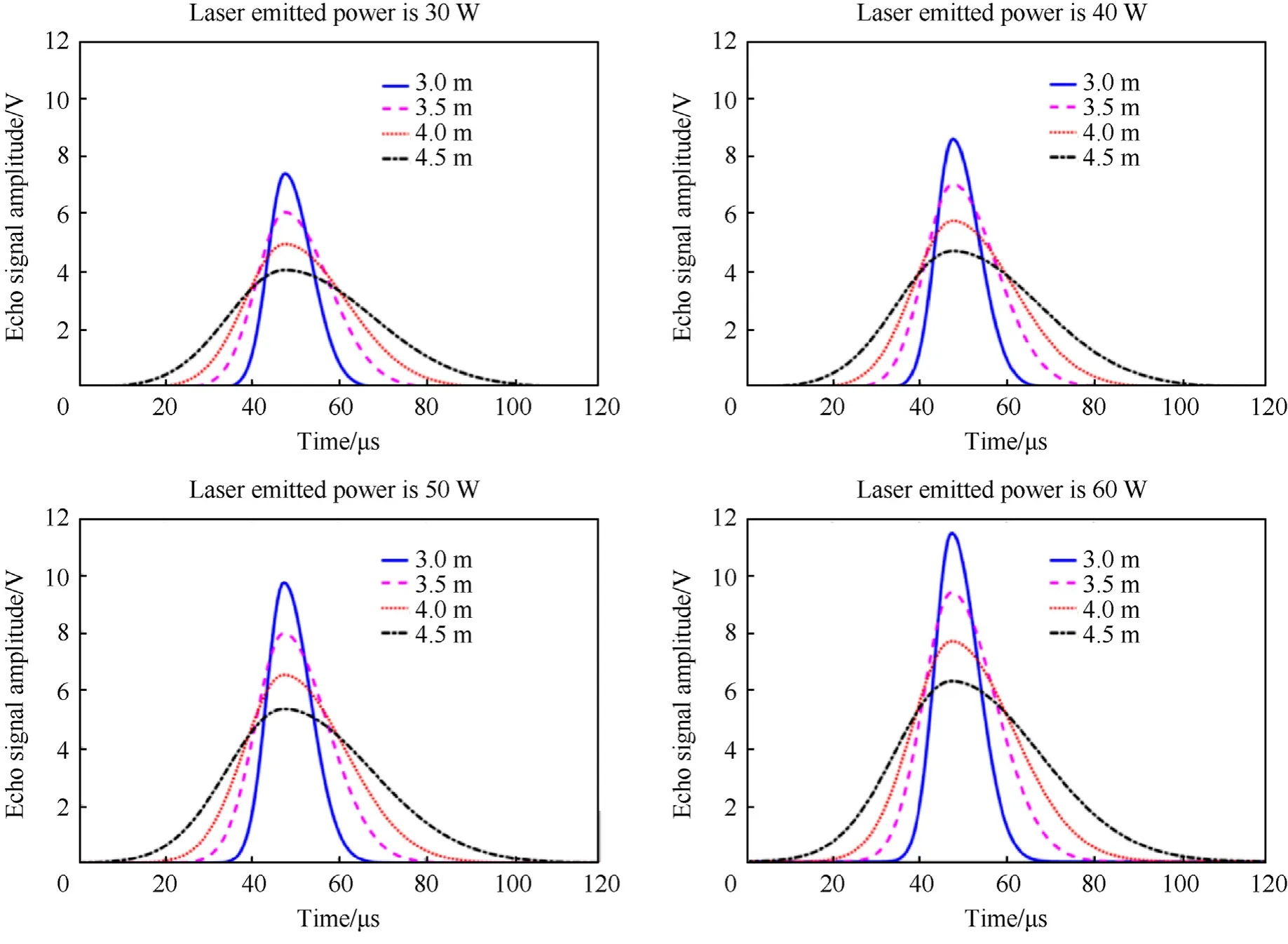
Fig.4.The relationship between the echo signal of the projectile and the detection distance under the different laser emitted power settings.
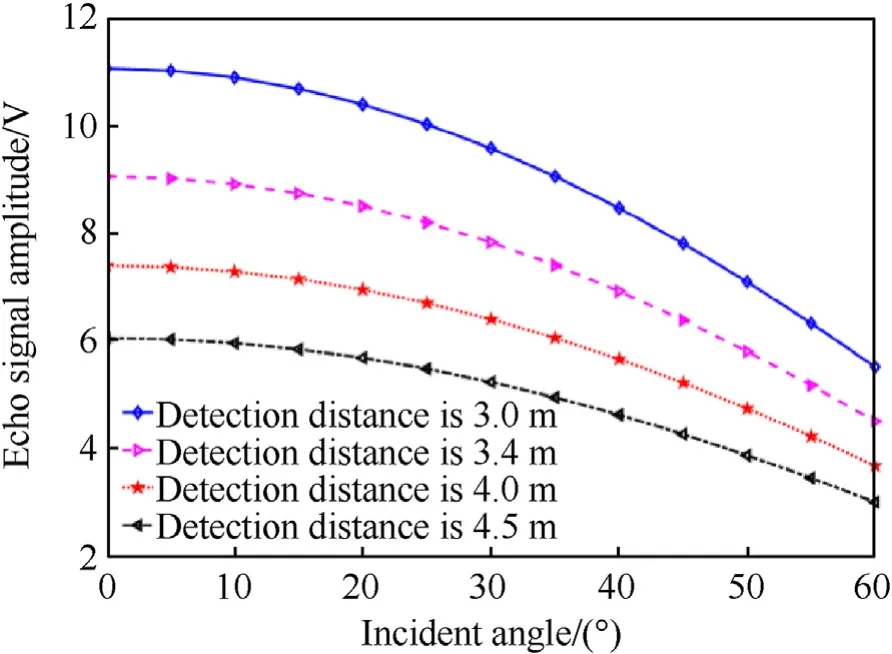
Fig.5.Projectile echo signal and detection distance at different incident angles.
The results show that the laser emitted power remains unchanged,the detection distance increases and the projectile echo power decreases.Under the same detection distance condition,the laser emitted power increases and the projectile echo power increases.Additionally,in order to obtain the same projectile echo power,the laser emitted power increases 10 W,the detection distance increases 0.8 m,the laser emitted power increases 20 W and the detection distance increases 1.3 m.The results show that the increase of the line laser emitted power and the echo power of the projectile obtained are not linearly related,with the main reason being that as the detection distance increases,the thickness of the line laser detection screen becomes thicker and the ratio of the reflective cross-sectional area of the projectile in the detection screen to the cross-sectional area of the detection screen at the height of the projectile is different.Two aspects need to be considered when the height of the flying projectile is increased.First,the thickness of the detection screen is smaller than the length of the flying projectile.On this basis,the flying height of the projectile increases and the echo power attenuation is not clear.Second,the thickness of the detection screen is greater than the length of the flying projectile.Under this condition,the flying height of the projectile increases and the echo power is greatly attenuated,which reflects that the ratio of the reflective crosssectional area of the projectile to the cross-sectional area of the detection screen has also greatly changed.Under this condition,the length of the projectile is smaller than the thickness of the detection screen and the cross-section of the projectile in the detection screen does not change.When the detection distance increases,the cross-section of the thickness of detection screen increases as well,but the cross-section area of the projectile itself does not change.According to formula(10),the laser echo power of the projectile obtained by the photoelectric detection receiver is decreased,only if the voltage signal generated by the echo energy of the projectile is less than the noise signal of the photoelectric detection system itself,that is,P′ Fig.6.The relationship between the laser emitted power and the detection circuit noise. When the flying projectile passes through the laser detection screen at different incident angles,the energy of the laser reflected on the surface of the projectile to the photoelectric detection receiver varies with the incident angleβ.When the laser emitted power is about 55 W,Fig.5 shows the curve of projectile echo signal and detection distance at different incident angles. From Fig.5,we can see that when the detection distance is 3 m,the echo energy reflected of the projectile is the biggest.Meantime,the greater is the incident angle,the smaller the echo energy reflected of the projectile at the same detection distance is.The main reason is that the actual reflected surface area of the projectile is cos β times the cross-sectional area of the projectile itself,that is,the energy reflected on the photoelectric detector receiver surface is reduced by cos β times.If the incident angle of the projectile remains the same,as the detection distance increases,the echo signal amplitude of the projectile decreases greatly. Increasing the laser emitted power is a feasible measure to improve the detection ability.However,the increase of the laser emitted power also affects the detection performance of line laser detection screen.The relationship between the laser emitted power and the detection circuit noise is displayed in Fig.6. According to the echo power function,the aperture diaphragm parameter of the lens is also a crucial factor restricting the detection ability.Fig.7 shows the curve of the echo signal of the projectile and the aperture diaphragm. Under the same focal length of the lens,the larger the optical aperture diaphragm is,the higher the projectile echo signal amplitude is,therefore,the more beneficial is to receive the energy reflected from the projectile.However,when the detection distance is greater than a certain threshold value,the aperture diaphragm of the lens increases and the echo signal change of the projectile is not detectable.This is mainly reflected in the fact that at a certain detection distance,all the reflected echo energy falls on the photosensitive surface of the photoelectric detection receiver when the surface area of the projectile is falling in the detection screen.In this case,increasing the optical aperture diaphragm does not increase the projectile echo signal amplitude,but the background noise is increased,which is not conducive to the detection of the projectile. Fig.7.Projectile echo signal and the aperture diaphragm relationship. Fig.8.The contrast collected projectile waveform with a detection distance of 1.66 m. 5.2.1.Detection capability test According to the optical structure and imaging principles,when the detection distance is 5 m,the thickness of the detection screen is 30 mm and the thickness of emitted line laser plane is consistent with the detection screen.In the experiment,an air gun was used to verify the detection performance of the system in the test.The diameter of the projectile was 4.5 mm,the length was 5.6 mm and the average flying velocity was about 145 m/s,the laser emitted power of the line laser detection screen is about 55 W,the acquisition card was used to collect the detection signal and the its frequency was 1 MHz.The two test devices were placed on the same trajectory,under different environments with the same projectile;comparative tests were carried out by using the traditional photoelectric detection target and new photoelectric detection target with line laser detection screen,and the saturation value of projectile signal amplitude for two detection sensors are both 11.7 V. In the first experiment,the sky illuminance was about 2800 Lx,the environment condition was the blue sky background and the detection distance was 1.66 m.The collected projectile waveform by the traditional photoelectric detection screen and the line laser detection screen are shown in Fig.8(a) and (b),respectively. Fig.9.Contrast collected projectile waveform at the detection distance of 3.55 m. In Fig.8(a),the peak signal of the projectile from the traditional photoelectric detection screen was less than 3.5 V and the average inherent noise signal was 1.28 V.Under this condition,the signalto-noise ratio of the traditional photoelectric detection screen output was only about 2.73 and the detection distance about was 368 times the diameter of the projectile.The average inherent noise signal in the line laser detection screen was 1.35 V,the projectile signal amplitude of line laser detection screen reached 11.5 V in Fig.8(b),the projectile signal amplitude reached a saturated state and the signal-to-noise ratio was 8.52.According to formulas (12)and (13),from the intensity of the background noise of line laser detection screen,the detection system generally requires a minimum signal-to-noise ratio of 1.8,so that the detection system is considered to be able to capture projectile information. The detection distance was 3.55 m,when the sky illuminance remains basically the same.The collected projectile waveform of the traditional photoelectric detection screen and the collected projectile waveform of line laser detection screen are shown in Fig.9(a) and (b),respectively. In Fig.9(a),the projectile signal amplitude of the traditional photoelectric detection screen is very small,the output signal of the projectile is less than 1.85 V,and the signal-to-noise ratio of the system is less than 1.44,so the information of the projectile cannot be distinguished from the noise signal,losing the information(Fig.9(a)).In contrast,the projectile signal amplitude of the line laser detection screen reached 8.42 V and the inherent noise of the detection system was 1.35 V.The signal-to-noise ratio of the line laser detection screen photoelectric sensor was 6.24 and the detection distance was 722 times the diameter of the projectile,which shows that the design of line laser detection screen has obvious advantages under the blue sky background. In the second experiment,the sky illuminance was low at about 580 Lx,the environment of the sky was relatively dark and the detection distance about was 1.45 m.The collected projectile waveform of the traditional photoelectric detection screen and the collected projectile waveform of the line laser detection screen are presented in Fig.10(a)and(b).The inherent noise signal output of the traditional photoelectric detection screen was slightly reduced on average,while the inherent noise of the line laser detection screen remained almost the same,which also shows that the inherent noise caused by dust particles does not change considerably under blue sky background conditions. From Fig.10(a) and (b),we can find that the traditional photoelectric detection screen was not able to detect the signal of the projectile,while the projectile signal amplitude by using the line laser detection screen reached 11.7 V and the projectile signal amplitude reached a saturated state.Under this background condition,Figs.11 and 12 present the collected projectile waveforms of line laser detection screen at detection distances of 3.62 m and 4.35 m,respectively. Fig.10.Contrast collected projectile waveform at detection distance of 1.45 m. Fig.11.Collected projectile waveforms of new photoelectric detection target at detection distance of 3.62 m. Fig.12.Collected projectile waveforms of new photoelectric detection target at detection distance of 4.35 m. The projectile signal amplitude reached 9.65 V and 7.26 V at detection distances of 3.62 m and 4.35 m,respectively(Figs.11 and 12).The results indicate that under low illuminance,the environmental stray light is less influential,the light signal reflected from the projectile has a stronger contrast and the projectile signal amplitude is larger than under illumination of 2800 Lx,showing that the line laser detection screen can achieve all-weather performance.The signal-to-noise ratio of the line laser detection screen is 7.15 at detection distance of 3.62 m,the results indicate that the design of the line laser detection screen can solve the detection problems of low illumination and blue sky background. Fig.13.Schematic diagram of the six line laser detection screen intersection system. From the test results of detection ability of new photoelectric detection target,it can be seen that the detection ability of the photoelectric detection target with the line laser detection screen as the core is restricted by the detection distance and the detection field of view.It is not difficult to find that the detection ability decreases with the increase of the detection distance.At the same time,for the same detection distance,the detection field of view increases,and the thickness of the formed detection screen increases,resulting in the detection ability reduced under the same environment,so,for photoelectric detection targets,the detection field of view is an inverse proportion to the detection ability.From the perspective of optical detection field of view,the detection field of view of new photoelectric detection target designed is more than 50,which is much larger than that of traditional photoelectric detection target.From the test results of detection ability,it can be found that the detection ability of new photoelectric detection target is better than that of traditional photoelectric detection target under low illumination conditions,especially when the background illumination is less than 3000 Lx. In the design of line laser detection screen,the laser emitted power is adjustable,and the selected laser emitted power can be determined according to the limiting detection distance of the detection projectile and the maximum value of the minimum detectable echo power.In order to meet the needs of different calibre projectile detection,the laser emitted power is adjusted according to the diameter of the projectile in the actual test. 5.2.2.Application and test A new photoelectric detection target with a line laser detection screen was used to form a six line laser detection screen intersection system.The principle of the spatial intersection mechanism is shown in Fig.13,where G-Gis six line laser detection screen,for the six detection screen intersection system,see Refs.[21,22].The laser emitted power of each line laser detection screen is still 55 W,the detection array of the six line laser detection screen intersection system was designed by using multiple line laser detection screens,among,the test system has three pairwise-parallel detection screens,Gand Gare parallel to each other and perpendicular to the z axis,the distance between Gand Gis s,called the target distance of the system;Gand Gare perpendicular to the xoz plane and the intersection angles with Gand Grespectively are both α;Gand Gare perpendicular to the yoz plane and the angles with Gand Grespectively are both β.When the projectile passes through six line laser detection screens,the projectile signal was collected the acquisition card,the values(t-t)were recorded six times by time value extraction criteria,and formula (14) was used to calculate the parameters of the flying projectile. Fig.14.Collected output signal of a projectile passing through the six line laser detection screen. In (14),γ and θ are the pitch and azimuth angles of the flight projectile,respectively. The third experiment was carried out,the sky illuminance was about 900 Lx,the average inherent noise of the six line laser detection screen was about 1.18 V;when the coordinates of the projectile was(0.26,3.81),Fig.14 shows the collected output signal of a projectile passing through the six line laser detection screen under low illumination environment. According to Fig.14,the peak of the projectile passing through the six line laser detection screen follows a law,which is determined by the inherent parameters of the six line laser detection screen intersection structure.Based on the six line laser detection screen intersection system and the parameters calculation model of flying projectile,Table 1 shows the amplitude of projectile signal of six projectiles passing through the six line laser detection screen,V-Vexpressed the projectile signal amplitude that the projectiles passes through the G-G,and the unit is volts.The test data on the flight parameter of six projectiles is shown in Table 2,its unit in meter. Table 1.Peak signal values of six projectiles passing through the six line laser detection screen. Table 2.Test data on the flight parameter. The signal peak of the projectile generated was basically in line with the projectile echo power theory.The line laser detection screens Gand Gare inclined relative to theGand G(Table 1).In other words,under the same detection distance,the distance between the projectile and the lens of line laser detection screen was relatively long and the output signal peak value was reduced accordingly.To the line laser detection screens Gand G,although they are all vertical trajectories,they also have an intersection angle withGand G.The detection distance for the projectile at the same position as Gand Galso changes,so the signal peak of the projectile in Gand Galso has obvious changes.From the test data in Table 1,it can be seen that the detection sensitivity of vertical detection screen is larger than that of inclined detection screen when a projectile passes through vertical and inclined detection screens.In addition,when the detection distance is same,the peak of projectile's signal is slightly smaller than the theoretical calculation value in the actual test.The main reason is that there are many factors of environmental impact in the actual test;some laser energy reflected of the projectile is absorbed by air particles,causes the reflected laser echo energy weakened.According to the test results of six detection screen intersection system,it is fully demonstrated that the photoelectric detection target with line laser detection screen in this paper can solve the detection ability under the environment illumination and the deep blue sky conditions. A new photoelectric detection target with a line laser detection screen was proposed in this paper,which addresses the requirements of acquiring dynamic projectile information in the weapon range and solves the problem of insufficient detection ability of conventional photoelectric detection target under low illumination or blue sky background.The projectile echo power model of the laser detection screen was established,based on the line laser detection screen.The relationship between detection distance and projectile echo power and the relationship between projectile flying angle and echo power of photoelectric detection receiver under different emitted power conditions were analyzed.The results showed that with the laser emitted power fixed,the detection distance increases,the echo power decreases,the incident angle of flying projectile increases and the echo power also decreases accordingly.Appropriately increasing the aperture diaphragm of the lens can improve the detection ability,but it also affects the signal-to-noise ratio of the system. Based on the experiment and tests under different illuminances,it was verified that the design method and theoretical calculation method proposed in this paper are feasible,and that the model of echo power and detectable minimum power of projectile established in this paper are rigorously formulated.The combination of a new photoelectric detection target with a line laser detection screen and a test system by with six line laser detection screens,solved the problem of low-illuminance detection ability of traditional photoelectric detection target,while retaining the advantage on multiple traditional photoelectric detection targets with passive detection test mechanism on the flight parameter of the projectile.The design and calculation method of this paper can provide new ideas for the all-weather application of photoelectric detection targets. This work has been supported by Project of the National Natural Science Foundation of China (No.62073256,61773305),in part by the Key Science and Technology Program of Shaanxi Province(No.2020GY-125) and Xi’an Science and Technology Innovation Talent Service Enterprise Project (No.2020KJRC0041). The authors declare that they have no known competing financial interests or personal relationships that could have appeared to influence the work reported in this paper.


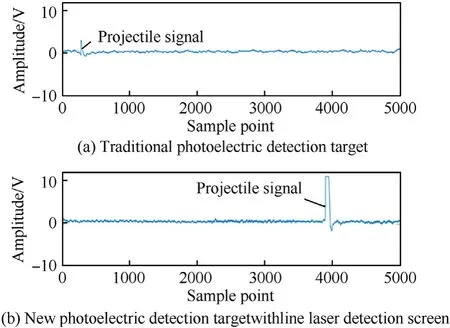
5.2.Experiment and analysis
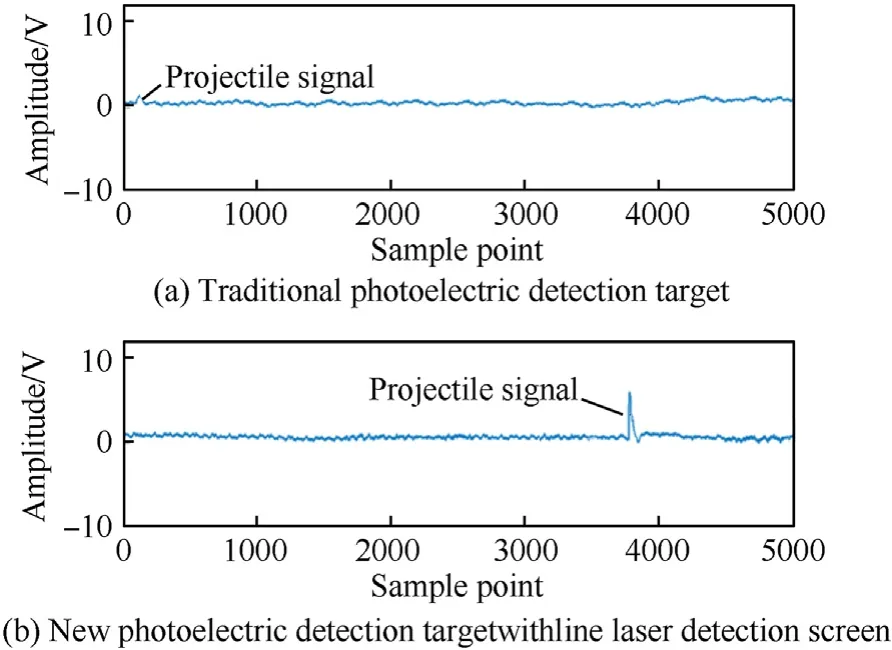
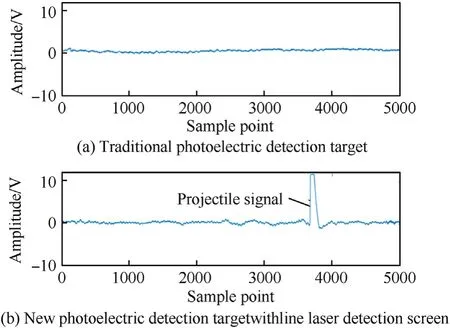

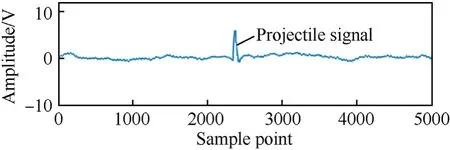


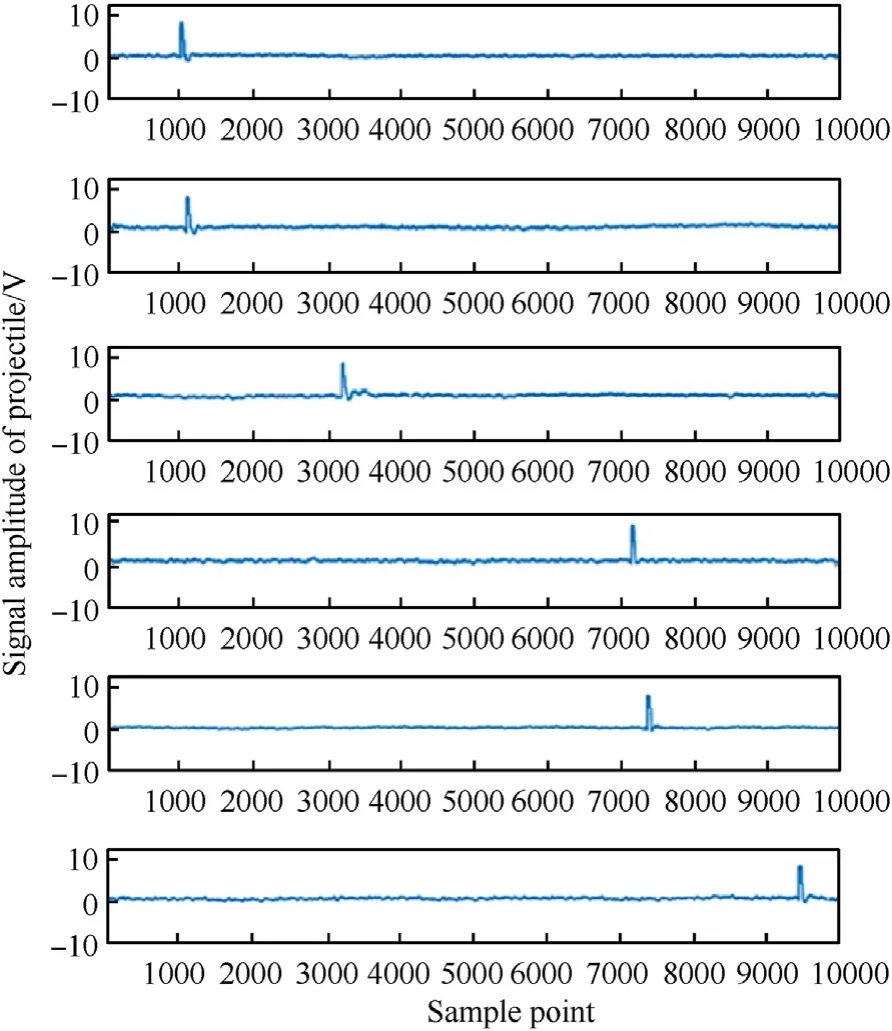


6.Conclusions
杂志排行
Defence Technology的其它文章
- Experimental study on propagation characteristics of rotating detonation wave with kerosene fuel-rich gas
- Adaptive robust control for triple avoidance -striking -arrival performance of uncertain tank mechanical systems
- Experimental study on WFeNiMo high-entropy alloy projectile penetrating semi-infinite steel target
- Numerical investigation of a muzzle multiphase flow field using two underwater launch methods
- Shock wave and bubble characteristics of underwater array explosion of charges
- A micro-chip exploding foil initiator based on printed circuit board technology
